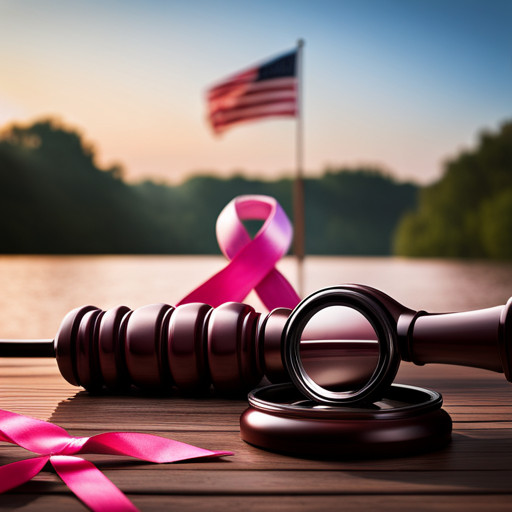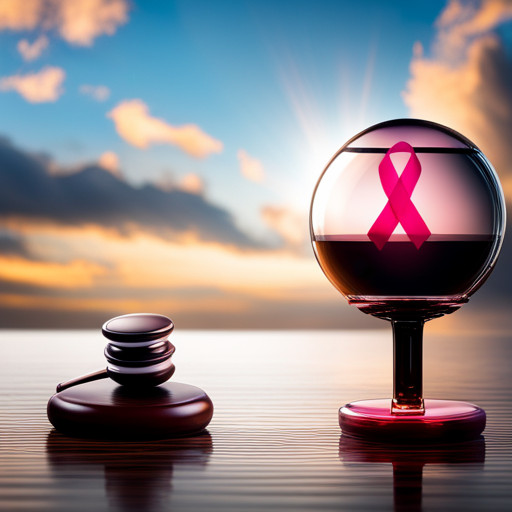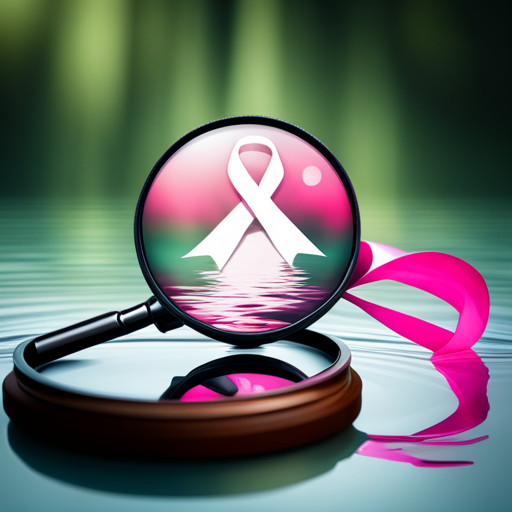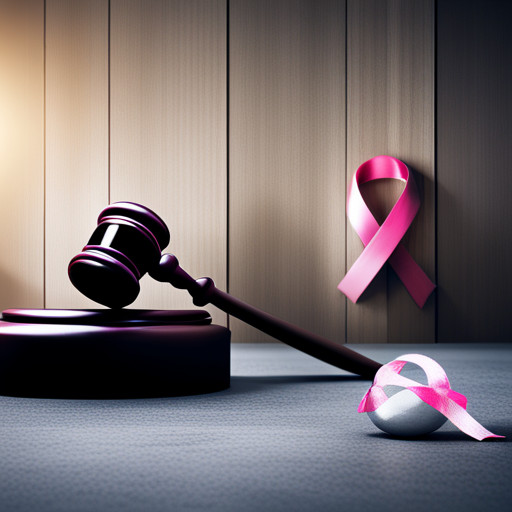Camp Lejeune Water Contamination Breast Cancer Lawsuits
The article explores the link between groundwater contamination at Camp Lejeune, a major U.S. Marine Corps base, and increased cancer risks.

It scrutinizes scientific research on toxic water, prevailing challenges in proving causation, particularly in women, and the uncommon occurrence of male breast cancer.
The article also discusses the implications of the contamination through an analysis of related lawsuits, offering a comprehensive view of this significant public health concern.
Key Takeaways
- The groundwater at Camp Lejeune was contaminated with carcinogenic chemicals, exceeding the maximum safe limits.
- Exposure to the contaminated water at Camp Lejeune increases the risk of cancer, including cervical and breast cancer.
- Many breast cancer lawsuits have been filed by women who allege that they developed the disease after working or living at Camp Lejeune.
- Male breast cancer, which is rare, is also linked to the contaminated water at Camp Lejeune, specifically to exposure to PCE and vinyl chloride.
The History of Camp Lejeune

Established as a significant U.S. Marine Corps training facility in North Carolina, Camp Lejeune gained notoriety when it was discovered that its groundwater was contaminated with carcinogenic chemicals such as perchloroethylene (PCE) and trichloroethylene (TCE) from August 1953 to December 1987, leading to an increased risk of cancer among its inhabitants and subsequent lawsuits.
The history of litigation surrounding this event is extensive, with cases brought forward by both military personnel and local civilians alike. These lawsuits have brought attention to the long-term health effects of such exposure, which include various forms of cancer and other serious health issues.
The legal proceedings have also highlighted the negligence and lack of oversight that contributed to the prolonged contamination. This dark chapter continues to influence regulations and protocols for environmental safety in military bases.
Understanding the Contamination at Camp Lejeune

The contamination event lasted for over thirty years before corrective action was taken.
Prolonged exposure to the contaminated water was linked to an increased risk of various types of cancer.
The government response included extensive investigations, remediation efforts, and subsequent health studies to assess the full extent of the potential health effects.
Following the realization of the toxic exposure at the military base, significant timelines were set in motion, which encompassed comprehensive investigations, legal actions, and remediation efforts.
This timeline of legal actions emerged as a critical aspect in the aftermath of the contamination. Several lawsuits ensued, notably the breast cancer lawsuits, wherein victims sought compensation for their suffering.
An exemplary case is Partain, et al. v. United States, which highlighted the gravity of the health implications as a result of the exposure. Despite the commonality of breast cancer in women, the causal links established in these lawsuits signified the potential hazards of the contamination.
The compensation for victims became a crucial part of the legal discourse, emphasizing the necessity for liability and responsibility in such grave situations.
Scientific Research on Toxic Water and Cancer

In-depth scientific investigations have identified a strong correlation between carcinogenic toxins found in groundwater and increased risk of various forms of cancer. The long-term health effects of water contamination, particularly at places like Camp Lejeune, are profound and alarming. Studies indicate a higher incidence of cancer, including breast cancer, among individuals exposed to the polluted water.
This understanding necessitates an urgent implementation of breast cancer prevention strategies. Such strategies might include:
- Regular screenings for early detection in populations exposed to toxic water.
- Education about potential risk factors and symptoms.
- Provision of clean water supplies and remediation of contaminated sources.
- Advocacy for stricter environmental regulations to prevent future contamination.
It is clear that the health repercussions of such environmental disasters extend far beyond their immediate impact, necessitating long-term solutions and prevention strategies.
A Closer Look at the Breast Cancer Studies

Scientific investigations into the high incidence of mammary gland malignancies have revealed a disturbing correlation with prolonged exposure to toxic substances at Camp Lejeune. An in-depth examination of the studies suggests that this correlation is not limited to the immediate effects but also extends to long-term health effects.
Notably, the impact of contamination on children has emerged as a significant concern. Children born to mothers exposed to the contaminated water are at a higher risk of developing health issues, including cancers, later in life.
Furthermore, the studies indicate a disturbing trend of increased cases of male breast cancer linked to the contamination.
Legal Proceedings Around Camp Lejeune Contamination

Legal proceedings surrounding the environmental disaster have brought to light the serious health implications and the failure of responsible parties to take timely action.
These proceedings, notably Partain et al. v. United States, have pivoted around compensation claims from those affected by the water contamination at Camp Lejeune.
Plaintiffs allege that exposure to the contaminated water led to the development of breast cancer. Causation, particularly in female breast cancer cases, presents a challenge due to the high prevalence of the disease.
However, the Camp Lejeune Justice Act (CLJA) adopts the equipoise causation standard, easing this burden of proof. Male breast cancer cases, due to their rarity, have found it easier to establish a causal link to the contaminated water.
The Case of Partain Vs. United States: A Detailed Study

In the case of Partain v. the United States, significant attention was directed towards a thorough exploration of the alleged health impact of toxic groundwater on the claimants. The claimants were former residents of Camp Lejeune, exposed to contaminated water. They attributed their health issues, including cancer, to this exposure. A critical aspect of the case was the establishment of causation between the exposure and the health issues. Compensation for victims was sought, emphasizing the need for the government to take responsibility.
This case underscored the gravity of environmental mismanagement and its dire consequences on public health.
The Role of Women in Camp Lejeune Lawsuits

The implications of these lawsuits have had profound impacts on families, not only in terms of seeking justice and compensation for their health struggles, but also in bringing the grave issue of environmental contamination to the forefront of public awareness.
Establishing Causation in Breast Cancer Cases

Establishing a causal link between chemical exposure and disease diagnosis is a critical factor in litigation related to health implications from environmental pollution. However, establishing causation in breast cancer cases, particularly from chemical exposure, presents notable challenges.
The high prevalence of breast cancer complicates the establishment of a direct link between environmental exposure and disease manifestation.
Firstly, the ubiquitous nature of this disease creates difficulties in delineating a clear cause-effect relationship.
Secondly, the latency period of breast cancer could extend to several decades, obscuring the link with specific chemical exposure.
Thirdly, genetic predisposition to breast cancer could confound the causal relationship.
Lastly, epidemiological studies often yield inconclusive results due to confounding factors and biases. Challenges, such as the long latency period of cancer, further complicate these efforts.
Thus, while proving causation is pivotal in such lawsuits, the inherent complexities require meticulous investigation and robust scientific evidence.
Breast Cancer: Facts and Figures

Breast malignancies represent a significant health burden, with statistics indicating that approximately one in nine women in the United States will receive a diagnosis at some point in their lifetime.
Breast cancer prevention strategies are paramount and encompass lifestyle modifications, including balanced diets and regular exercise, to limit risk factors. Advances in genetic testing also contribute to early detection and prevention.
Parallel to prevention, research has yielded new treatments for breast cancer, enhancing survival rates and improving the quality of life. These treatments range from advancements in surgical techniques to novel pharmaceutical interventions.
Despite the progress, continuous research is needed to further understand this complex disease and develop more effective prevention strategies and treatments.
Male Breast Cancer: An Uncommon Occurrence

Exploring the potential correlation between male mammary carcinoma and exposure to polluted water has been a focus of recent scientific investigations. The rare occurrence of breast cancer in males, in particular those exposed to the contaminated water at Camp Lejeune, has led to a heightened interest in this potential link.
The case of Camp Lejeune is particularly compelling. The link between male breast cancer and the contaminated water at the military base has been substantiated through specific studies. These studies established not only the presence of carcinogenic substances in the water but also their potential role in the manifestation of male breast cancer.
Findings from the ATSDR study highlighted a substantial association between male mammary carcinoma and exposure to PCE and vinyl chloride in the North Carolina military base's water supply.
The investigation has considered:
- The high levels of carcinogenic chemicals in the water.
- The duration of exposure to these chemicals.
- The incidence of male breast cancer among those exposed.
- The causal factors and environmental impacts of the contamination.
Given the uncommon occurrence of this disease in men, these findings underscore the potential of environmental factors in disease causation, providing significant insights into the health consequences of environmental contamination.
The implications of these findings are immense, not only for the individuals affected but also for future environmental policy and public health measures.
Frequently Asked Questions
What Support Is Available for Those Affected by the Water Contamination at Camp Lejeune?
Support for those affected by Camp Lejeune water contamination includes legal assistance and compensation claims.
Legal assistance helps victims navigate complex litigation processes, while compensation claims provide financial relief for health-related expenses.
The U.S. Department of Veterans Affairs recognizes several conditions related to this contamination, potentially qualifying affected individuals for benefits.
Legal provisions, such as the Camp Lejeune Justice Act, also facilitate the pursuit of compensation for health issues linked to the contamination.
Can Other Health Conditions Besides Cancer Be Linked to the Water Contamination at Camp Lejeune?
Contamination symptoms beyond cancer have been associated with exposure to toxic substances at Camp Lejeune. These include neurological disorders, birth defects, and fertility issues.
The Lejeune Legacy documents numerous health conditions in former residents and employees. However, establishing a definitive causative link between specific health conditions and exposure to contaminated water often requires extensive epidemiological studies.
Thus, the full spectrum of potential health impacts remains an area of ongoing research.
How Has the Water Contamination at Camp Lejeune Impacted the Environment in the Area?
The aftermath of contamination at Camp Lejeune has had significant environmental implications. The pollutants in the groundwater have not only affected human health but also the local wildlife and ecosystems.
Biodiversity may be negatively impacted, as the contaminants could alter the habitat and food sources of various species. Moreover, the contamination could disrupt the equilibrium of the ecosystem, leading to unforeseen long-term effects.
Further research is needed to quantify and address these environmental impacts.
How Has the U.S. Marine Corps Responded to the Contamination and Subsequent Lawsuits?
The U.S. Marine Corps has faced significant legal implications stemming from the Camp Lejeune water contamination. In response, efforts have been made to address Marine Corps accountability, including the establishment of health care benefits for affected veterans and their families.
However, the Corps has faced criticism for its handling of the issue, particularly in its communication with veterans and in its approach to addressing the myriad lawsuits arising from the contamination incident.
Are There Any Preventative Measures in Place Now to Avoid Future Contamination at Camp Lejeune or Other Similar Facilities?
To mitigate future instances of contamination, rigorous monitoring systems have been implemented at facilities similar to Camp Lejeune. These systems aim to detect potential contaminants early, thereby preventing extensive exposure.
Additionally, protective legislation has been enacted to enforce strict environmental standards and to mandate prompt response to any identified contamination.
This combination of regular contamination monitoring and robust legal safeguards works to protect the health and safety of individuals inhabiting such facilities.




